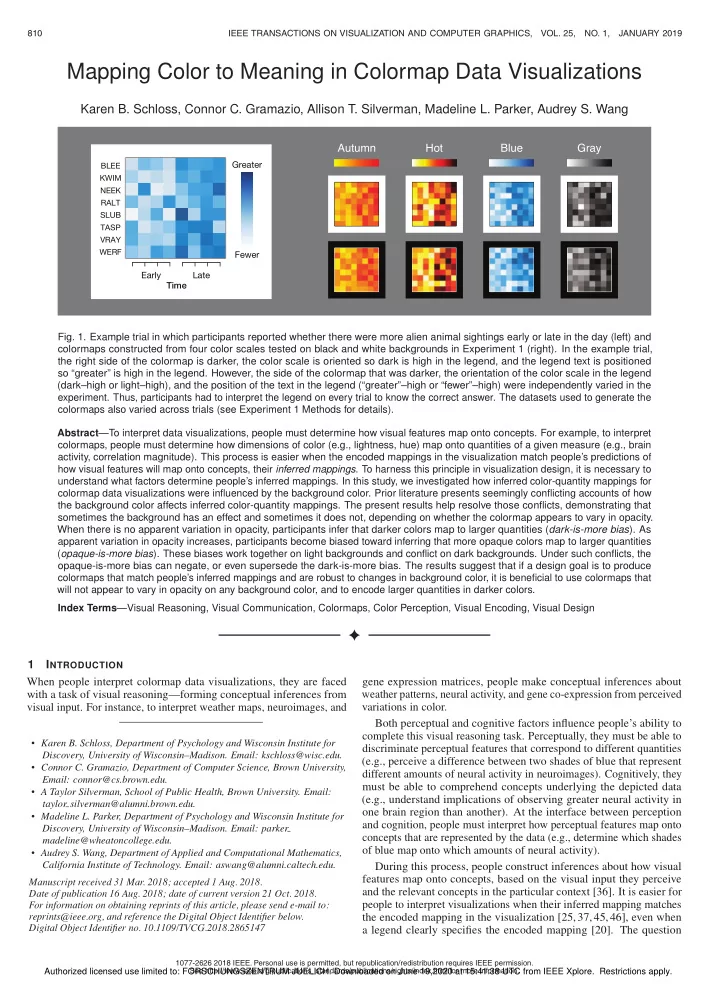

Discovery, University of Wisconsin–Madison. Email: kschloss@wisc.edu. • Karen B. Schloss, Department of Psychology and Wisconsin Institute for • • • California Institute of Technology. Email: aswang@alumni.caltech.edu. • udrey S. Wang, Department of pplied and Computational Mathematics, • Connor C. Gramazio, Department of Computer Science, Brown University, Email: connor@cs.brown.edu. • Taylor Silverman, School of Public Health, Brown University. Email: • Madeline L. Parker, Department of Psychology and Wisconsin Institute for Discovery, University of Wisconsin–Madison. Email: parker madeline@wheatoncollege.edu. 810 IEEE TRANSACTIONS ON VISUALIZATION AND COMPUTER GRAPHICS, VOL. 25, NO. 1, JANUARY 2019 Mapping Color to Meaning in Colormap Data Visualizations Karen B. Schloss, Connor C. Gramazio, Allison T. Silverman, Madeline L. Parker, Audrey S. Wang Autumn Hot Blue Gray Greater BLEE KWIM NEEK RALT SLUB TASP VRAY WERF Fewer Early Late Time Fig. 1. Example trial in which participants reported whether there were more alien animal sightings early or late in the day (left) and colormaps constructed from four color scales tested on black and white backgrounds in Experiment 1 (right). In the example trial, the right side of the colormap is darker, the color scale is oriented so dark is high in the legend, and the legend text is positioned so “greater” is high in the legend. However, the side of the colormap that was darker, the orientation of the color scale in the legend (dark–high or light–high), and the position of the text in the legend (“greater”–high or “fewer”–high) were independently varied in the experiment. Thus, participants had to interpret the legend on every trial to know the correct answer. The datasets used to generate the colormaps also varied across trials (see Experiment 1 Methods for details). Abstract —To interpret data visualizations, people must determine how visual features map onto concepts. For example, to interpret colormaps, people must determine how dimensions of color (e.g., lightness, hue) map onto quantities of a given measure (e.g., brain activity, correlation magnitude). This process is easier when the encoded mappings in the visualization match people’s predictions of how visual features will map onto concepts, their inferred mappings . To harness this principle in visualization design, it is necessary to understand what factors determine people’s inferred mappings. In this study, we investigated how inferred color-quantity mappings for colormap data visualizations were influenced by the background color. Prior literature presents seemingly conflicting accounts of how the background color affects inferred color-quantity mappings. The present results help resolve those conflicts, demonstrating that sometimes the background has an effect and sometimes it does not, depending on whether the colormap appears to vary in opacity. When there is no apparent variation in opacity, participants infer that darker colors map to larger quantities ( dark-is-more bias ). As apparent variation in opacity increases, participants become biased toward inferring that more opaque colors map to larger quantities ( opaque-is-more bias ). These biases work together on light backgrounds and conflict on dark backgrounds. Under such conflicts, the opaque-is-more bias can negate, or even supersede the dark-is-more bias. The results suggest that if a design goal is to produce colormaps that match people’s inferred mappings and are robust to changes in background color, it is beneficial to use colormaps that will not appear to vary in opacity on any background color, and to encode larger quantities in darker colors. Index Terms —Visual Reasoning, Visual Communication, Colormaps, Color Perception, Visual Encoding, Visual Design 1 I NTRODUCTION When people interpret colormap data visualizations, they are faced gene expression matrices, people make conceptual inferences about with a task of visual reasoning—forming conceptual inferences from weather patterns, neural activity, and gene co-expression from perceived visual input. For instance, to interpret weather maps, neuroimages, and variations in color. Both perceptual and cognitive factors influence people’s ability to complete this visual reasoning task. Perceptually, they must be able to discriminate perceptual features that correspond to different quantities (e.g., perceive a difference between two shades of blue that represent different amounts of neural activity in neuroimages). Cognitively, they must be able to comprehend concepts underlying the depicted data (e.g., understand implications of observing greater neural activity in taylor silverman@alumni.brown.edu. one brain region than another). At the interface between perception and cognition, people must interpret how perceptual features map onto concepts that are represented by the data (e.g., determine which shades of blue map onto which amounts of neural activity). During this process, people construct inferences about how visual features map onto concepts, based on the visual input they perceive Manuscript received 31 Mar. 2018; accepted 1 Aug. 2018. and the relevant concepts in the particular context [36]. It is easier for Date of publication 16 Aug. 2018; date of current version 21 Oct. 2018. people to interpret visualizations when their inferred mapping matches For information on obtaining reprints of this article, please send e-mail to: reprints@ieee.org, and reference the Digital Object Identifier below. the encoded mapping in the visualization [25,37,45,46], even when Digital Object Identifier no. 10.1109/TVCG.2018.2865147 a legend clearly specifies the encoded mapping [20]. The question 1077-2626 2018 IEEE. Personal use is permitted, but republication/redistribution requires IEEE permission. Authorized licensed use limited to: FORSCHUNGSZENTRUM JUELICH. Downloaded on June 19,2020 at 15:41:38 UTC from IEEE Xplore. Restrictions apply. See http://www.ieee.org/publications_standards/publications/rights/index.html for more information.
Recommend
More recommend